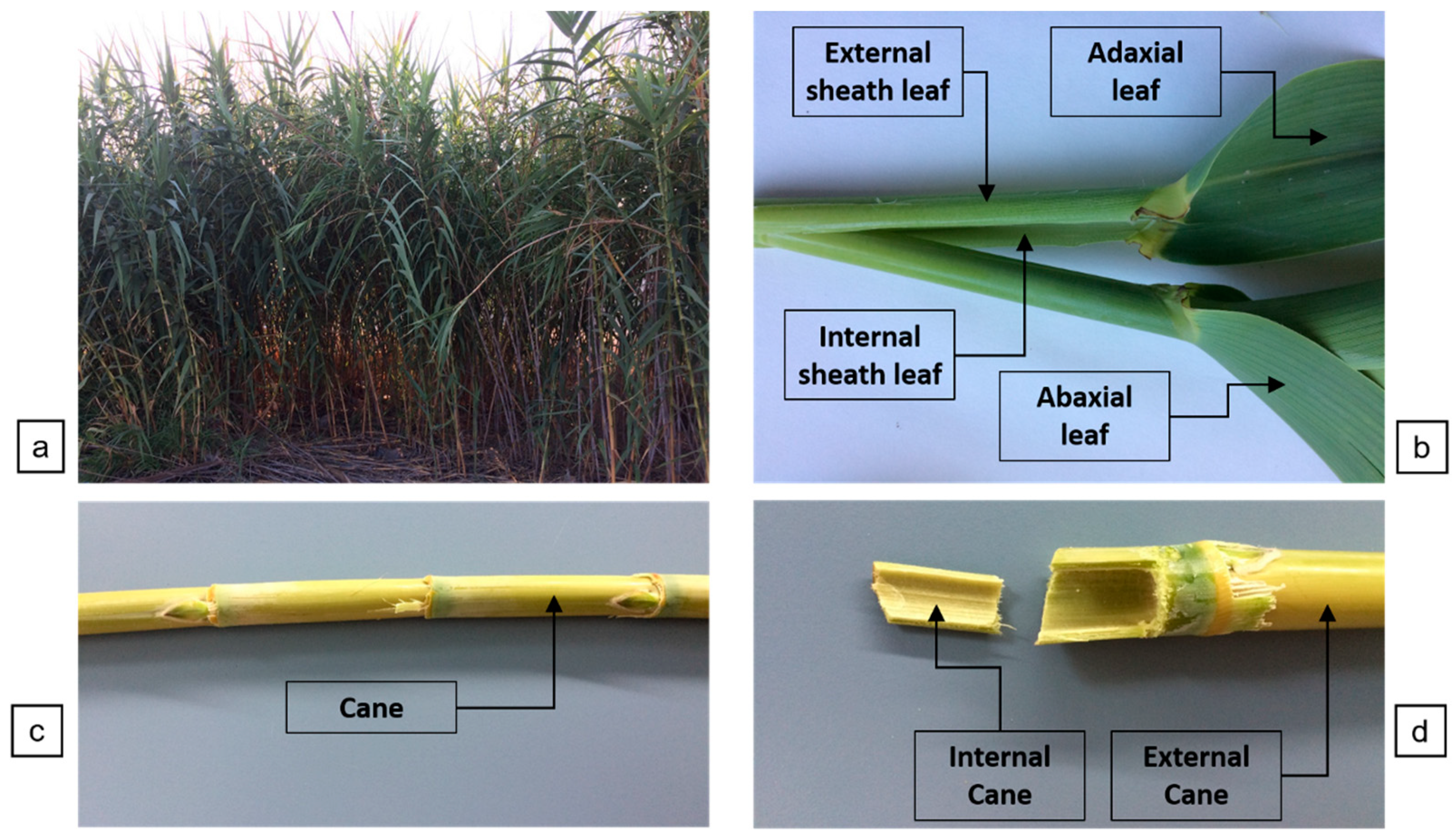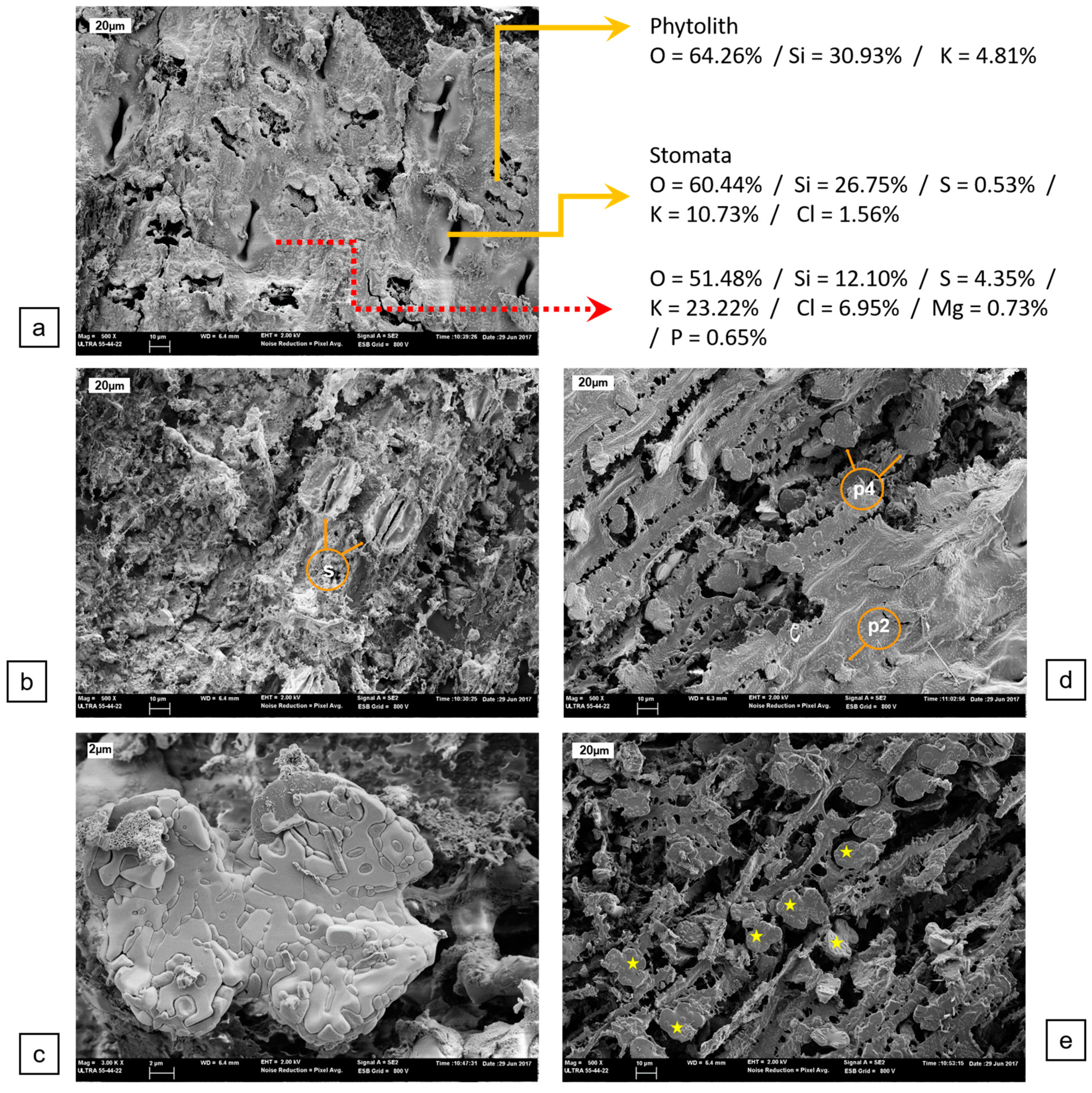An Approach to a New Supplementary Cementing Material: Arundo donax Straw Ash
Abstract
:1. Introduction
2. Materials and Methods
3. Results and Discussion
3.1. FESEM Analysis of Dried Samples at 105 °C
3.2. FESEM Analysis of Calcined Samples at 450 °C
3.3. Pozzolanic Reactivity
4. Conclusions
Author Contributions
Funding
Acknowledgments
Conflicts of Interest
References
- González Bejarano, S.; Silva Delgado, E. Arundo donax L.: Material de construcción. Proyecto Final de Grado. Universitat Politècnica de Catalunya, Barcelona, Spain. 2012. Available online: https://core.ac.uk/download/pdf/41807621.pdf (accessed on 27 September 2018). (In Spanish).
- Sanz Elorza, M.; Dana Sánchez, E.D.; Sobrino Vesperinas, E. Atlas de las Plantas Alóctonas Invasoras en España; Ministerio de Medio Ambiente, Dirección General para la Biodiversidad: Madrid, Spain, 2004; 384p, ISBN 84-8014-575-7. (In Spanish) [Google Scholar]
- Angelini, L.G.; Ceccarini, L.; Bonari, E. Biomass yield and energy balance of giant reed (Arundo donax L.) cropped in central Italy as related to different management practices. Eur. J. Agron. 2005, 22, 375–389. [Google Scholar] [CrossRef]
- Krička, T.; Matin, A.; Bilandžija, N.; Jurišić, V.; Antonović, A.; Voća, N.; Grubor, M. Biomass valorisation of Arundo donax L., Miscanthus × giganteus and Sida hermaphrodita for biofuel production. Int. Agrophys. 2017, 31, 575–581. [Google Scholar] [CrossRef]
- Chauhan, D.K.; Tripathi, D.K.; Kumar, D.; Kumar, Y. Diversity, distribution and frequency based attributes of phytolith in Arundo donax L. Int. J. Innov. Biol. Chem. Sci. 2011, 1, 22–27. [Google Scholar]
- Payá, J.; Monzó, J.; Borrachero, M.V. Outstanding aspects on the use of rice husk ash and similar agrowastes in the preparation of binders. In Proceedings of the Pro-Africa Conference: Non Conventional Building Materials Based on Agroindustrial Wastes, Pirassununga, Brazil, 18–19 October 2010. [Google Scholar]
- Zain, M.F.M.; Islam, M.N.; Mahmud, F.; Jamil, M. Production of rice husk ash for use in concrete as a supplementary cementitious material. Constr. Build. Mater. 2011, 25, 798–805. [Google Scholar] [CrossRef]
- Moraes, J.C.B.; Akasaki, J.L.; Melges, J.L.P.; Monzó, J.; Borrachero, M.V.; Soriano, L.; Payá, J.; Tashima, M.M. Assessment of sugar cane straw ash (SCSA) as pozzolanic material in blended Portland cement: Microstructural characterization of pastes and mechanical strength of mortars. Constr. Build. Mater. 2015, 95, 670–677. [Google Scholar] [CrossRef]
- Cordeiro, G.C.; Toledo Filho, R.D.; Tavares, L.M.; Fairbaim, E.M.R. Pozzolanic activity and filler effect of sugar cane bagasse ash in Portland cement and lime mortars. Cem. Concr. Compos. 2008, 30, 410–418. [Google Scholar] [CrossRef]
- Pereira, A.; Akasaki, J.L.; Melges, J.L.P.; Tashima, M.M.; Soriano, L.; Borrachero, M.V.; Monzó, J.; Payá, J. Mechanical and durability properties of alkali-activated mortar based on sugarcane bagasse ash and blast furnace slag. Ceram. Int. 2015, 41, 13012–13024. [Google Scholar] [CrossRef] [Green Version]
- Roselló, J.; Soriano, L.; Santamarina, M.P.; Akasaki, J.L.; Monzó, J.; Payá, J. Rice straw ash: A potential pozzolanic supplementary material for cementing systems. Ind. Crops Prod. 2017, 103, 39–50. [Google Scholar] [CrossRef]
- Memon, S.A.; Wahid, I.; Khan, M.K.; Tanoli, M.A.; Bimaganbetova, M. Environmentally friendly utilization of wheat straw ash in cement-based composites. Sustainability 2018, 10, 1322. [Google Scholar] [CrossRef]
- Memon, S.A.; Khan, M.K. Ash blended cement composites: Eco-friendly and sustainable option for utilization of corncob ash. J. Clean. Prod. 2018, 175, 442–455. [Google Scholar] [CrossRef]
- Cordeiro, G.C.; Sales, C.P. Pozzolanic activity of elephant grass ash and its influence on the mechanical properties of concrete. Cem. Concr. Compos. 2015, 55, 331–336. [Google Scholar] [CrossRef]
- Cordeiro, G.; Sales, C.P. Influence of calcining temperature on the pozzolanic characteristics of elephant grass ash. Cem. Concr. Compos. 2016, 73, 98–104. [Google Scholar] [CrossRef]
- Nakanishi, E.Y.; Frías, M.; Santos, S.F.; Rodrigues, M.S.; Villa, R.V.V.; Rodriguez, O.; Savastano, H., Jr. Investigating the possible usage of elephant grass ash to manufacture the eco-friendly binary cements. J. Clean. Prod. 2016, 116, 236–243. [Google Scholar] [CrossRef] [Green Version]
- Ismail, Z.Z.; Jaeel, A.J. A novel use of undesirable wild giant reed biomass to replace aggregate in concrete. Constr. Build. Mater. 2014, 67 Part A, 68–73. [Google Scholar] [CrossRef]
- Vassilev, S.V.; Baxter, D.; Andersen, L.K.; Vassileva, C.G. An overview of the chemical composition of biomass. Fuel 2010, 89, 913–933. [Google Scholar] [CrossRef] [Green Version]
- Payá, J.; Monzó, J.; Borrachero, M.; Díaz-Pinzón, L.; Ordóñez, L. Sugar-cane bagasse ash (SCBA): Studies on its properties for reusing in concrete production. J. Chem. Technol. Biotechnol. 2002, 77, 321–325. [Google Scholar] [CrossRef]
- Antiohos, S.; Maganari, K.; Tsimas, S. Evaluation of blends of high and low calcium fly ashes for use as supplementary cementing materials. Cem. Concr. Compos. 2005, 27, 349–356. [Google Scholar] [CrossRef]
- AENOR. Fly Ash for Concrete. Part 1: Definition, Specifications and Conformity Criteria; UNE-EN 450-1; AENOR: Madrid, Spain, 2013. [Google Scholar]
- AENOR. Silica Fume in Concrete. Part 1: Definitions, Requirement and Conformity Criteria; UNE-EN 13263-1; AENOR: Madrid, Spain, 2009. [Google Scholar]
- Zhang, Z.; Zhang, B.; Yan, P. Comparative study of effect of raw and densified silica fume in the paste, mortar and concrete. Constr. Build. Mater. 2016, 105, 82–93. [Google Scholar] [CrossRef]
- Tangpagasit, J.; Cheerarot, R.; Jaturapitakkul, C.; Kiattikomol, K. Packing effect and pozzolanic reaction of fly ash in mortar. Cem. Concr. Res. 2005, 35, 1145–1151. [Google Scholar] [CrossRef]
- De Weerdt, K.; Kjellsen, K.O.; Sellevold, E.; Justnes, H. Synergy between fly ash and limestone powder in ternary cements. Cem. Concr. Compos. 2011, 33, 30–38. [Google Scholar] [CrossRef]















| Treatment | Plant Part | Key | Observations |
|---|---|---|---|
| Dried at 105 °C | Cane | C-E | External part |
| C-I | Internal part | ||
| Sheath leaf | S-E | External part | |
| S-I | Internal part | ||
| Leaf | L-Ab | Abaxial part | |
| L-Ad | Adaxial part | ||
| Calcined at 450 °C | Cane | AC-E | Ash skeleton of the external part |
| AC-I | Ash skeleton of the internal part | ||
| Sheath leaf | AS-E | Ash skeleton of the external part | |
| AS-I | Ash skeleton of the internal part | ||
| Leaf | AL-Ab | Ash skeleton of the abaxial part | |
| AL-Ad | Ash skeleton of the adaxial part |
| Part | AC-E | AC-I | AS-E | AS-I | AL-Ab | AL-Ad |
|---|---|---|---|---|---|---|
| Element | Mean (SD) * | Mean (SD) * | Mean (SD) * | Mean (SD) * | Mean (SD) * | Mean (SD) * |
| O | 37.42 (±1.06) | 37.17 (±1.15) | 47.15 (±2.25) | 49.1 (±5.36) | 51.06 (±4.28) | 52.26 (±1.93) |
| Na | 0 (0) | 0 (0) | 0.19 (±0.13) | 0.03 (±0.08) | 0 (0) | 0 (0) |
| Mg | 0 (0) | 0.04 (±0.14) | 1.55 (±0.58) | 0.66 (±0.47) | 1.34 (±0.61) | 1.08 (±0.44) |
| Al | 0 (0) | 0 (0) | 0.02 (±0.06) | 0.01 (±0.05) | 0.01 (±0.05) | 0 (0) |
| Si | 0.69 (±1.04) | 0.11 (±0.23) | 6.68 (±1.9) | 11.03 (±7.64) | 9.76 (±7.19) | 15.39 (±3.63) |
| P | 3.83 (±0.28) | 4.2 (±1.07) | 0.64 (±0.16) | 0.43 (±0.27) | 1.48 (±0.65) | 1.25 (±0.54) |
| S | 1.14 (±0.27) | 1.43 (±0.64) | 5.34 (±0.4) | 4.19 (±1.93) | 4.36 (±1.67) | 2.01 (±0.94) |
| Cl | 11.06 (±2.4) | 12.83 (±2.4) | 9.89 (±2.32) | 8.91 (±3.69) | 6.54 (±2.93) | 5.52 (±1.54) |
| K | 45.76 (±2.92) | 44.19 (±2.49) | 27.81 (±2.06) | 25.58 (±6.88) | 23.83 (±5.22) | 22.47 (±3.2) |
| Ca | 0 (0) | 0 (0) | 0.68 (±0.89) | 0 (0) | 1.57 (±0.73) | 0 (0) |
| Atomic ratios | ||||||
| Cl/K | 0.24 | 0.29 | 0.36 | 0.35 | 0.27 | 0.25 |
| Si/K | 0.02 | 0.00 | 0.24 | 0.43 | 0.41 | 0.68 |
| XRF Data | EDX Data | XRF Data | EDX Data | ||
|---|---|---|---|---|---|
| Element | % | % | Oxide | % | % |
| Na | 0.01 | 0.12 | Na2O | 0.01 | 0.07 |
| Mg | 5.62 | 2.32 | MgO | 6.04 | 1.77 |
| Al | 0.34 | 0.03 | Al2O3 | 0.41 | 0.03 |
| Si | 25.66 | 21.40 | SiO2 | 35.47 | 24.78 |
| P | 2.90 | 1.90 | P2O5 | 4.29 | 2.62 |
| S | 1.27 | 7.94 | SO3 | 2.05 | 12.07 |
| Cl | 13.08 | 15.41 | Cl2O | 10.34 | 12.76 |
| K | 37.99 | 49.75 | K2O | 29.54 | 44.70 |
| Ca | 12.85 | 1.13 | CaO | 11.61 | 1.21 |
| Fe | 0.27 | 0.00 | Fe2O3 | 0.25 | 0.00 |
| Mortar | Flexural Strength (MPa) | Compressive Strength (MPa) | ||
|---|---|---|---|---|
| 28 days | 90 days | 28 days | 90 days | |
| Control | 6.8 ± 0.5 | 7.7 ± 0.5 | 56.1 ± 1.6 | 59 ± 2 |
| 25% ADSA | 5.1 ± 0.5 | 7.0 ± 0.5 | 60.2 ± 1.2 | 65 ± 2 |
| 25% filler | 6.1 ± 0.2 | 6.4 ± 0.2 | 40 ± 2 | 44.0 ± 1.4 |
© 2018 by the authors. Licensee MDPI, Basel, Switzerland. This article is an open access article distributed under the terms and conditions of the Creative Commons Attribution (CC BY) license (http://creativecommons.org/licenses/by/4.0/).
Share and Cite
Payá, J.; Roselló, J.; Monzó, J.M.; Escalera, A.; Santamarina, M.P.; Borrachero, M.V.; Soriano, L. An Approach to a New Supplementary Cementing Material: Arundo donax Straw Ash. Sustainability 2018, 10, 4273. https://doi.org/10.3390/su10114273
Payá J, Roselló J, Monzó JM, Escalera A, Santamarina MP, Borrachero MV, Soriano L. An Approach to a New Supplementary Cementing Material: Arundo donax Straw Ash. Sustainability. 2018; 10(11):4273. https://doi.org/10.3390/su10114273
Chicago/Turabian StylePayá, Jordi, Josefa Roselló, José María Monzó, Alejandro Escalera, María Pilar Santamarina, María Victoria Borrachero, and Lourdes Soriano. 2018. "An Approach to a New Supplementary Cementing Material: Arundo donax Straw Ash" Sustainability 10, no. 11: 4273. https://doi.org/10.3390/su10114273
APA StylePayá, J., Roselló, J., Monzó, J. M., Escalera, A., Santamarina, M. P., Borrachero, M. V., & Soriano, L. (2018). An Approach to a New Supplementary Cementing Material: Arundo donax Straw Ash. Sustainability, 10(11), 4273. https://doi.org/10.3390/su10114273








